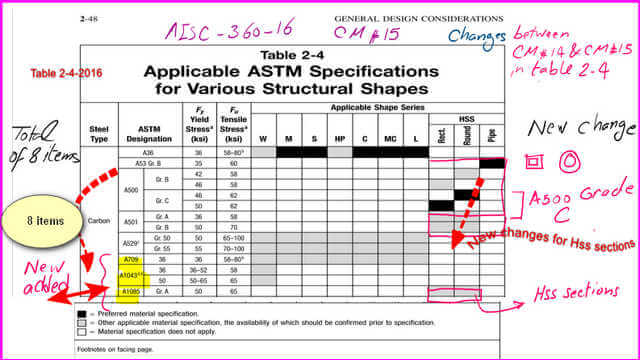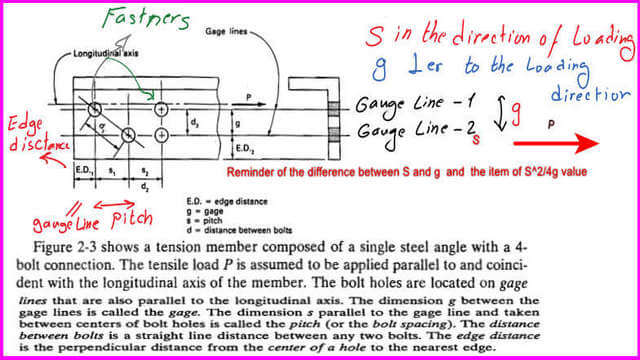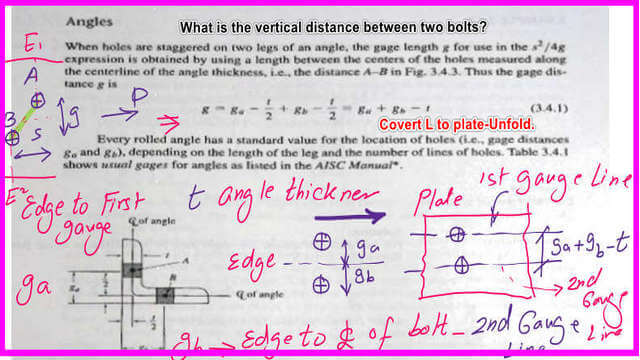Last Updated on June 30, 2025 by Maged kamel
Workable gauge lines for distances at an angle.
The Workable gauge Line distance for angle is essential for finding the net area for staggered Bolts in tension.
Types of limit states for Tension Members.
This summarizes the Limit states for the tension members; two conditions are considered: the limit state of yielding and the limit state of rupture.
We will review the essential equations used for the nominal strength of tensile members according to failure phenomena. If yielding, the Pn=fy*Ag, where Fy is the yield stress, and Ag is the gross area.
The parameter of the LRFD is φt=0.90, while the parameter of the ASD is Ωt=1.67.
A split due to the fracture takes place, passing through line-crossing bolts.
For the second case of tensile rupture, the LRFD parameter φt=0.75, while Ωt=1.67=2.0.
Our main equation, Pn = fult*Aeff, compares the two cases and selects the lesser value after considering the application of the various coefficients. Comparing the LRFD cases together, if wishing to check based on LRFD, include the φt.

For ASD, consider the Ωt for each failure case, then take the lesser value. The following slide shows Table 2-4 for various types of shapes.

Table 2-5 contains the Applicable ASTM specifications for plates and bars. Table 2-5 for the Applicable ASTM specifications for Plates and bars.

Detailed Sketch for the gauge lines.
The following slide reviews the gauge lines. The first gauge line and the second gauge line are in the direction of the force, and the difference between g and s distances between bolts.

The vertical distance between the gauge lines is g, and the distance between the centerlines of bolts is S, which is called the pitch.
Workable gages in angle legs in inches- Table 1-7A-CM#15.
The following slide includes Table 1- 7A for an equal or Unequal angle based on CM#15.
This table gives the workable gauges in angle legs in inches. For instance, as per our example for an angle 6×4 inches, if we wish to put one line of bolts from the leg of the angle, use the first horizontal represented by g for the 6-inch leg. We select 3 1/2 inches for the other leg, 4 inches; we are only allowed to have one gauge line with a distance equal to 2 1/2 inches from the edge.
For a leg with an angle equal to 6 inches, we can have two gauge lines, g1 and g2. The distance for g1 is 2 1/4 inches, while for the second gauge line, it is 2 1/2 inches.

Tables for various structural shapes.
The tables for the different shapes are shown. We can get the required properties, such as area, Ix, Iy, rx, and ry.
HP shapes, C shapes, Mc shapes, angles to get the required properties, area, Ix, Iy, rx, and ry, etc. W shapes, wide flange shapes, and M shapes.
Starting -30 from the AISC manual from pages 30 to 31, data for the S shape from page 32, then HPp shapes for piles sections, c channels from 1-36, while for the MC shapes from 1-38, and the angles from page 1-42.
Table 1-1 for W shapes.
Table 1-2 for M shapes.
Table 1-3 for S shapes.
Table 1-4 for HP shapes.
Table 1-5 for C shapes.
Table 1-6 for MC shapes.
Table 1-7 for angles. Other shapes are also shown in the next slide image.

The vertical distance g between Bolts for an angle.
The following slide shows how to estimate the gauge distance for an angle by considering the centerline distance between the centers of the bolts.
From Prof. Salmon’s book, if there is a section on an angle. The given ga is the first gauge line, as shown on the lower side of an angle measured from the edge of the angle to the centerline of the fastener. At the same time, gb is the distance measured from the edge to the centerline of the fastener but vertically.
The g stands for gauge distance between the centerlines of bolts, estimated by converting the angle into a plate looking from the inner side of the angle.

The distance between the cl of the bolts, g=ga + gb – t/2-t/2, so finally=ga+gb-t, where t is the thickness of the angle.
The following post solved problems for the net area estimation
For a good reference, here are the types of tension members in structural steel construction.